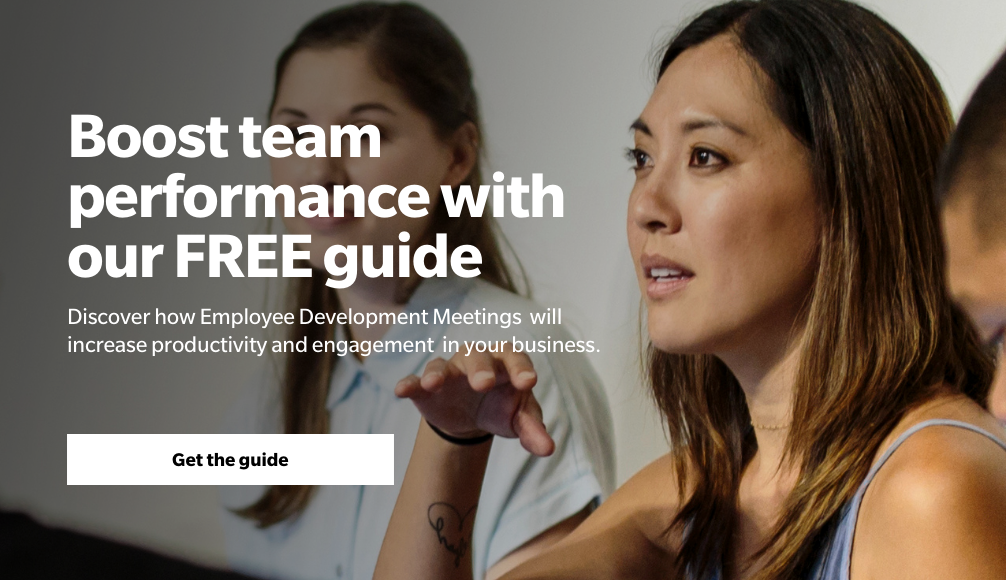Imagine a company culture where you and your team are in perfect alignment with the vision and goals you have for your company. It might seem like a pipe dream, but it’s entirely possible and within your control. With the right approach to team engagement through effective one-on-one meetings with your employees that mean something to them, you’ll eventually find yourself surrounded by people who are properly prepared to meet their own responsibilities—and are delighted to do so.
These sessions—what we call Employee Development Meetings (EDMs)—are a key tool for building a high-performance environment that will help better manage your employees and help your team reach its full potential. And if you ever want to develop a company that runs the way you want without depending so much on you, there’s no time to lose.
Why development conversations are important
Everyone wants to feel valued and successful in their work and know that what they do is not only helping the company, but taking them somewhere in their professional growth. Just imagine a workplace where your employees think to themselves:
I’m excited about my work.
This is a place where I can achieve my goals.
I feel safe making mistakes, and I’ll learn from them.
I have some great ideas on how to improve things. I can’t wait to share them with my manager.
Employee meetings foster that kind of engagement and employee motivation. Of course, it helps to hire excellent people who share your values from the start. But developing your team goes beyond hiring. Even the best employees need your help realizing their potential. Regular conversations will motivate your team to do better, feel valued for their contributions and look for ways to move beyond their limitations.
And these meetings have the added benefit of taking pressure off your schedule. It may seem counterintuitive, but EDMs are meant to condense many smaller conversations into a single, focused one-on-one. You’ll start to see less random drop-ins, email exchanges and other interruptions, freeing up time for you and your managers to focus on your own goals.
What to cover in your one-on-one meeting
The development meeting is a regularly-scheduled and ongoing session between an employee and their direct supervisor that’s a:
- Forum to discuss, problem-solve, resolve conflicts and plan. It should give your employees the experience of feeling listened to and empowered to take action.
- Time to discuss current work in order to: make agreements on goals, priorities and exceptions, exchange information, clarify procedures and results, and conduct follow-ups.
- Coaching session that helps people stay on track and focus on their goals (both personal and professional) so their experience in your business becomes more positive and meaningful.
These regular meetings give your employees a predictable touchpoint to discuss their wins, questions, concerns, blocks and requests—and they also give you an opportunity to assess where your employees currently are and challenge any assumptions you may be making about them. At a minimum, schedule a 30- to 60-minute weekly meeting, and be sure to:
- Discuss ground rules for the relationship: What can you expect from each other?
- Provide an overview of the meeting: What are the logistics and topics to discuss?
- Review current work.
- Discuss each employee’s professional goals.
Rules and roles within employee meetings
If weekly EDMs make sense for your company, work with your managers to establish a meeting structure, and have them do the same with their reporting employees. Managers should schedule regular weekly meetings for at least three months at a time. And here’s where the time-saving benefit of EDMs comes into play—once your team’s one-on-ones are scheduled, look for opportunities to eliminate the non-essential meetings that've been bogging you down.
The employee and their supervising manager each play a different role in the meeting. The manager’s role is to be:
- Consistent: Set the frequency, regular time and basic agenda for the meeting, and stick to it. Promptly reschedule any missed meetings.
- Present: Conduct meetings in a quiet place free of interruptions and distractions so that real dialogue is possible.
- Committed: Inquire, listen and secure commitments. Find out what’s going on with employees (good and bad), address work-related issues, announce new projects and tasks, answer or clarify any questions and set clear expectations regarding responsibilities.
The employee's role is to:
- Provide updates, not excuses: Be prepared to report on project statuses and let managers know about delays before they happen.
- Ask questions, and ask for help when needed: Open, two-way exchanges like these let both parties share the responsibility to bring up topics, communicate needs and discuss issues.
- Show their commitment: When problems arise that prevent your employees from meeting their responsibilities and achieving the results they agreed to when they took their role, they need to commit to improving their skills and performance.
The result: Increased performance and retention
One of the most effective ways to get your team on board with your goals is through face-to-face contact and straightforward communication. When you and your managers are on the same page with each employee regarding projects, responsibilities, and personal or work-related issues, you won’t need all the extra emails and meetings that rarely resolve anything.
In a high-performance environment, everyone needs to know more than the basics of their responsibilities and the “general purpose” of the company. If you’d like better performance from your people—and if you want them to stick around—they need to share your vision, enrich it with their perspective and feel it aligns with their own professional vision. When you create a safe place for development, your employees and managers will be able to communicate more deeply about their work, performance and goals.
Whatever result you’re pursuing, purpose-driven meetings like these will move you and your employees one step closer to the satisfying, motivating work environment that most people dream of, but few ever experience.
Employee meetings foster that kind of engagement. Of course, it helps to hire excellent people who share your values from the start. But developing your team goes beyond hiring. Even the best employees need your help realizing their potential. Regular conversations will motivate your team to do better, feel valued for their contributions and look for ways to move beyond their limitations.
And these meetings have the added benefit of taking pressure off your schedule. It may seem counterintuitive, but EDMs are meant to condense many smaller conversations into a single highly-focused one-on-one. You’ll start to see less random drop-ins, email exchanges and other interruptions, freeing up time for you and your managers to focus on your own goals.
What to cover in your one-on-one meeting
The development meeting is a regularly-scheduled and ongoing session between an employee and their direct supervisor that’s a:
- Forum to discuss, problem-solve, resolve conflicts and plan. It should give your employees the experience of feeling listened to and empowered to take action.
- Time to discuss current work in order to: make agreements on goals, priorities and exceptions, exchange information, clarify procedures and results, and conduct follow-ups.
- Coaching session that helps people stay on track and focus on their goals (both personal and professional) so their experience in your business becomes more positive and meaningful.
Regular, ongoing meetings give your employees a predictable touchpoint to discuss their wins, questions, concerns, blocks and requests—and they also give you an opportunity to assess where your employees are currently at and challenge any assumptions you may be making about them. At a minimum, schedule a 30- to 60-minute weekly meeting, and be sure to:
- Discuss ground rules for the relationship: What can you expect from each other?
- Provide an overview of the meeting: What are the logistics and topics to discuss?
- Review current work.
- Discuss each employee’s professional goals.
Rules and roles within employee meetings
If weekly EDMs make sense for your company, work with your managers to establish a meeting structure, and have them do the same with their reporting employees. Managers should schedule regular weekly meetings for at least three months at a time. And here’s where the time-saving benefit of EDMs comes into play—once your team’s one-on-ones are scheduled, look for opportunities to eliminate the non-essential meetings that have been bogging you down.
The employee and their supervising manager each play a different role in the meeting. The manager’s role is to be:
- Consistent: Set the frequency, regular time and basic agenda for the meeting, and stick to it. Promptly reschedule any missed meetings.
- Present: Conduct meetings in a quiet place free of interruptions and distractions so that real dialogue is possible.
- Committed: Inquire, listen and secure commitments. Find out what’s going on with employees (good and bad), address work-related issues, announce new projects and tasks, answer or clarify any questions and set clear expectations regarding responsibilities.
The employee's role is to:
- Provide updates, not excuses: Be prepared to report on project statuses and let managers know about delays before they happen.
- Ask questions, and ask for help when needed: Open, two-way exchanges like these let both parties share the responsibility to bring up topics, communicate needs and discuss issues.
- Show their commitment: When problems arise that prevent your employees from meeting their responsibilities and achieving the results they agreed to when they took their role, they need to commit to improving their skills and performance.
The result: Increased performance and retention
One of the most effective ways to get your team on board with your goals is through face-to-face contact and straightforward communication. When you and your managers are on the same page with each employee regarding projects, responsibilities, and personal or work-related issues, you won’t need all the extra emails and meetings that rarely resolve anything.
In a high-performance environment, everyone needs to know more than the basics of their responsibilities and the “general purpose” of the company. If you’d like better performance from your people—and if you want them to stick around—they need to share your vision, enrich it with their perspective and feel it aligns with their own professional vision. When you create a safe place for development, your employees and managers will be able to communicate more deeply about their work, performance and goals.
Whatever result you’re pursuing, purpose-driven meetings like these will move you and your employees one step closer to the satisfying, motivating work environment that most people dream of, but few ever experience.




Comments